The last time that I wrote about sweet peas I promised that this year I would follow the progress of my crop so that you can see how they develop over the season rather than just reading about my sowing techniques in January. Just in case you missed it you can read Part 1 of my series here.
This week In Part 2 I want to look at the progress of my 'Winter Sunshine' seedlings and show you how the sweet pea seeds sown in January are progressing, as well as sharing the varieties I have chosen to grow this year. I have also decided to answer some of the questions and share some suggestions left in the comments in my last sweet pea post.
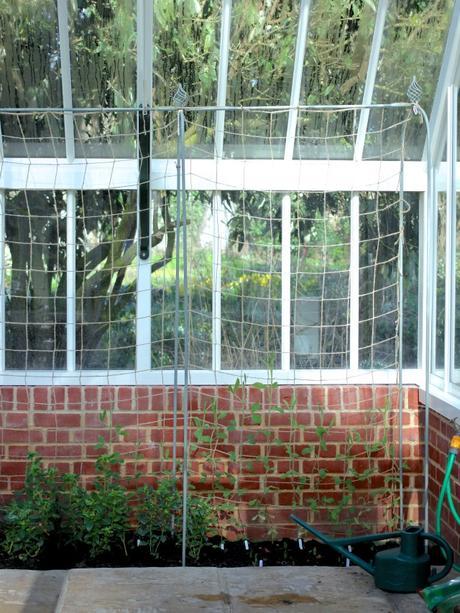
Before I start I have some very exciting news - Agriframes have generously offered 5 lots of the lovely jute netting as a GiveAway for my readers this month. I use this every year and am always delighted with it - it is easy to use, looks lovely and goes in the compost at the end of the season - perfect!! This means that 5 lucky readers will be able to sample some jute netting - just in time for planting out your sweet peas (or garden peas or beans if you would like to use it for vegetables). This GiveAway is only open to my UK readers - please leave a comment on this post stating that you would like your name to be entered in the draw. I will notify the 5 UK winners next week, who will then need to email me their addresses so that the jute netting can be posted on to them.
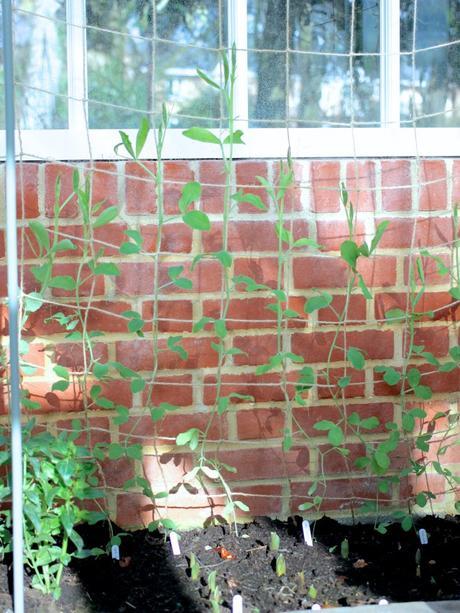
Returning to the business of growing sweet peas, you may remember that back in October I ordered a selection of Winter Sunshine sweet pea seeds from Owl's Acre Seeds. These are seeds which are bred to grow well under cover in low light conditions, so they are ideal for growing in a greenhouse or polytunnel. The seeds were soaked and sown straight away and I planted the young seedlings into the narrow border in my greenhouse in early January. I use an Agriframe Elegance Runner Bean Frame with jute netting for the sweet peas to climb up. The plants are already approaching a metre in height and are being feed every week with a seaweed feed. Last year I was a little later getting going with my winter variety of sweet peas and I still had flowers before the end of April! This year I am optimistic that flowering will start in March as long as there are no unexpectedly cold snaps which could slow them down.
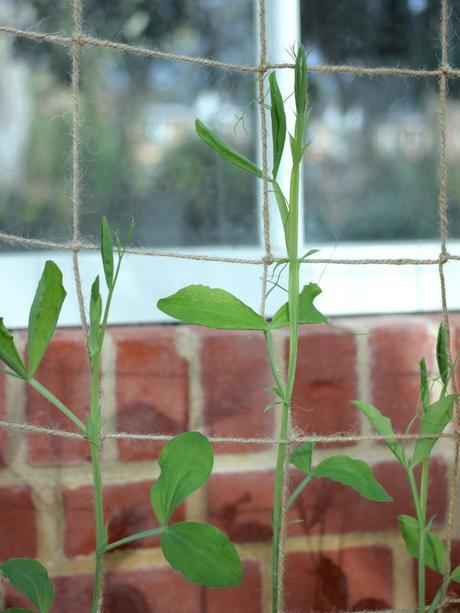
Last year was the first time I had grown winter variety sweet peas in my greenhouse and I found this method of growing under cover was extremely successful. I imagine that it would work well in hotter climates where sweet peas do not succeed when grown outside - in the garden they do best in cooler climates and require a lot of regular water, so anywhere hot and dry is going to struggle to grow them. If these winter variety seeds are sown in early autumn and then grown on under cover in the winter I would expect a very early crop could be achieved in a greenhouse or polytunnel, I cannot test this out myself, but would be very pleased if anyone growing in hot dry conditions would like to give this a go and report back next spring.

I will be watching my under cover sweet peas very carefully over the next few weeks and will let you know when the first flowers appear.
My summer sweet peas, which will be planted out into the garden, were sown in January and have all germinated now. I just have one more packet of seed to sow which is a mixture of dark shades called the Venetian Sweet Pea Mix from Sarah Raven that I ordered late. The packet has just arrived so I will be soaking the seeds overnight and sowing them tomorrow. The trays of seedlings will be moved into my cold frame in the next week or two and I hope to plant them out in late March. These seedlings will survive well in the deep root trainers they were sown in for quite a few weeks, but I will start to feed them weekly at the end of February to make sure they keep growing healthily until I can plant them out.
Just to recap from my last post - I have weeded the bed where they will be planted and I will be digging in some well rotted manure before the end of February so that it can settle into the soil before I transplant the seedlings into the ground.
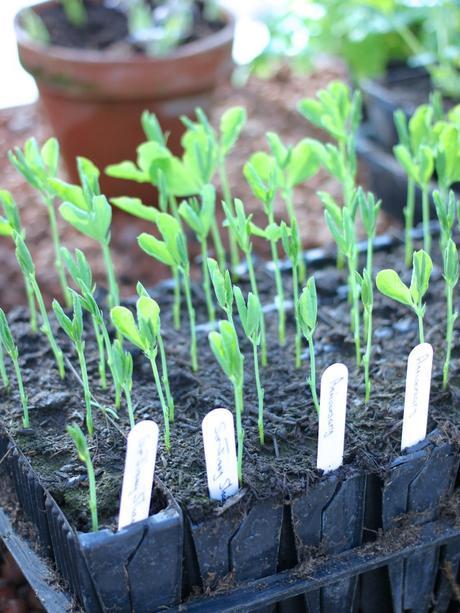
The taller seedlings were sown 2 weeks before the tray below.
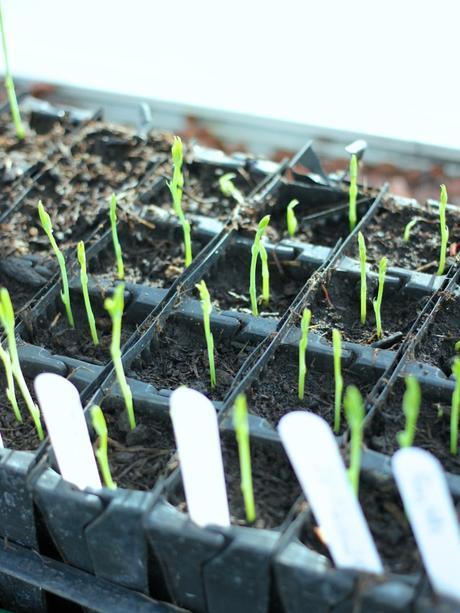
The varieties that I am growing this year are a mix of old favourites and a few new ones. From Owl's Acre Seeds I have sown a selection of my favourite Spencer varieties:
- Gwendoline
- White Frills
- Anniversary
- Sir Jimmy Shard
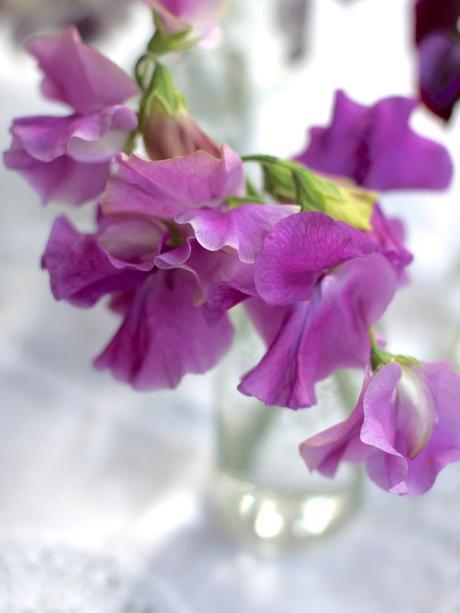
The new varieties are from Mr Fothergill's and are:
- Oxford Blue (modern hybrid)
- Rosy Frills (Spencer variety)
- Charles Angel (Spencer variety)
- Flagship (Spencer variety)
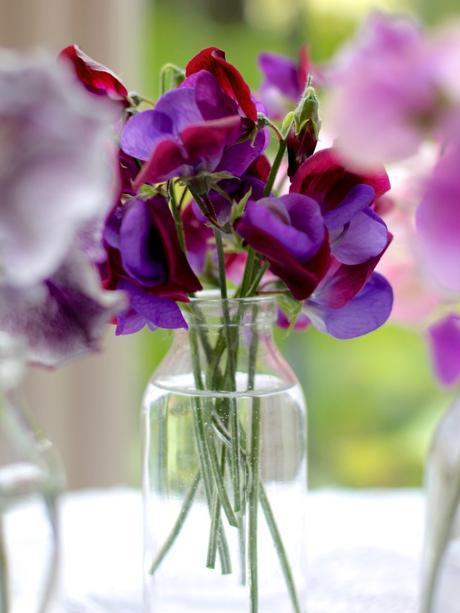
As I mentioned above I also have a mixed packet of dark shades to sow to make sure I have some contrasting colours.
Thank you all for your interest in my last sweet pea post - I was delighted toI receive some very useful comments and questions and I thought it would be helpful to share some of these with you today.
1. Keeping Pollen Beetles Off Sweet Pea FlowersI have really struggled with my garden sweet peas for the past two years as they have been covered in tiny pollen beetles which make them unusable as cut flowers. Teresa suggested not only cutting the flowers and leaving them in a cool dark shed or garbage overnight but also to put a brown paper bag over the flowers to really cut out the light - the idea is that the beetles will leave the flowers in search of daylight. I will certainly be trying this method of clearing the flowers of bugs in the summer, so thank you for this tip Teresa.
2. Protecting Seedlings From MiceMany readers struggle with mice in their greenhouses. Mice love sweet peas seeds and often destroy a newly planted crop. I have been very lucky so far (I am touching wood as I say this) as the mice have stayed out of my greenhouse. Anna from Green Tapestry suggested covering new sowings with a clear propagator lid to protect the seeds - once the plants get going the mice seem to leave them alone. Although I do not have mice in my greenhouse the Cutting Garden is home to plenty of mice, so I know that I could never get away with direct sowing my sweet pea seeds in the garden.
3. Why Have My Plants Got Powdery MildewJulia who grows in Canada was discouraged to find her sweet peas drying out from the bottom up the stems and the leaves developing powdery mildew. My first suggestion is to make sure the plants are well watered and that the ground around them is mulched to preserve the moisture - sweet peas hate to have dry roots. The hotter and more humid the climate the greater the problems with powdery mildew will be. You can treat it with a chemical control if you want to go that route or for organic gardeners I have read that spraying plants with 2/3 tablespoons of baking soda dissolved in a gallon of water once a week will help - this is just a suggestion as I have never tried it. It is hard to stop the stems from drying out lower down as sweet peas tend to flower from higher and higher up the stems as the season progresses, although cutting out dry sideshoots will help with the look of the plants. I grow sweet peas for a short crop of 6-8 weeks (I have usually had enough of dead heading by then) and will take them out as soon as they start to look tatty or overgrown. As a result I have usually pulled them out before any problems develop. I find the sweet pea frame is a great support for a late crop of runner or french beans, so will often compost the plants in mid August to free up the space.
4. Feeding Sweet Pea SeedlingsCathy from Rambling In The Garden asked whether I feed my garden sweet pea seedlings when I am feeding my winter sweet pea plants growing in the greenhouse. I did mention this above, but thought it worth repeating as feeding is so important. From the end of February, every week when I feed my plants growing in the greenhouse bed I will also feed the root trainers to make sure that these seedlings do not go short of food. I use a seaweed feed that I mix in with a watering can of water.
Please do leave any questions that you have in the comments below and also do please share your sweet pea growing experiences here throughout this year - I would love to hear how your sweet peas are getting on.
I am keeping my fingers crossed that lots of you will enter the generous Jute Netting GiveAway - just say that you would like to be entered in the draw in the comments below for a chance to win one of 5 sets of Agriframe's Jute Netting!! Please remember is only open to UK readers.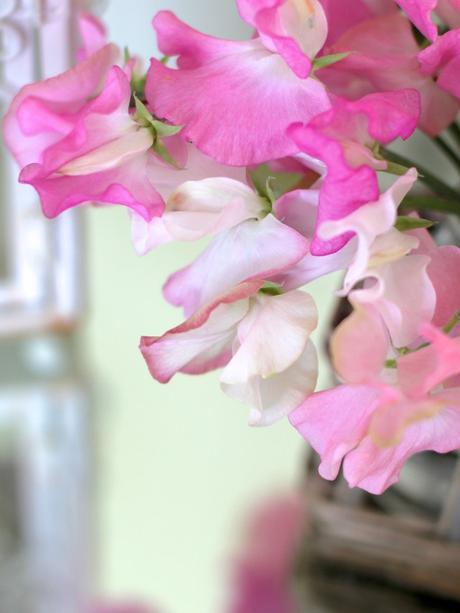
Finally, I must say a very big thank you to Agriframes for sponsoring this post - I will be back with Part 3 in March when I plant my young seedlings outside.

The last time that I wrote about sweet peas I promised that this year I would follow the progress of my crop so that you can see how they develop over the season rather than just reading about my sowing techniques in January. Just in case you missed it you can read Part 1 of my series here.
This week In Part 2 I want to look at the progress of my 'Winter Sunshine' seedlings and show you how the sweet pea seeds sown in January are progressing, as well as sharing the varieties I have chosen to grow this year. I have also decided to answer some of the questions and share some suggestions left in the comments in my last sweet pea post.
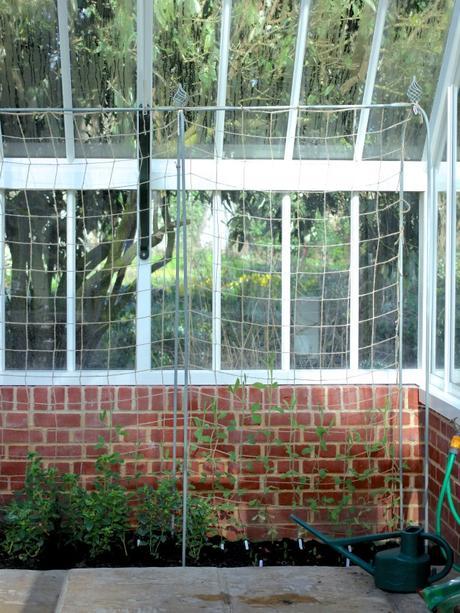
Before I start I have some very exciting news - Agriframes have generously offered 5 lots of the lovely jute netting as a GiveAway for my readers this month. I use this every year and am always delighted with it - it is easy to use, looks lovely and goes in the compost at the end of the season - perfect!! This means that 5 lucky readers will be able to sample some jute netting - just in time for planting out your sweet peas (or garden peas or beans if you would like to use it for vegetables). This GiveAway is only open to my UK readers - please leave a comment on this post stating that you would like your name to be entered in the draw. I will notify the 5 UK winners next week, who will then need to email me their addresses so that the jute netting can be posted on to them.
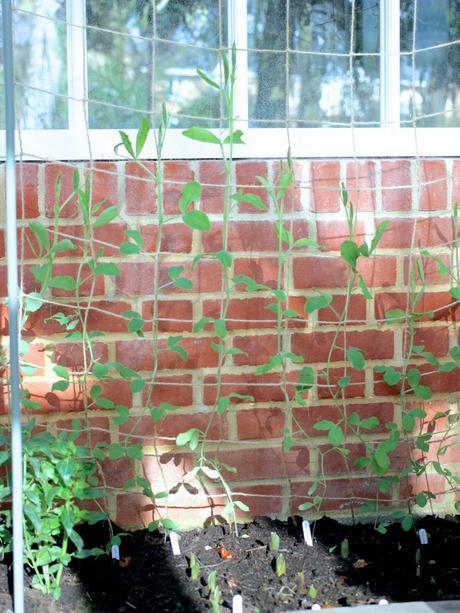
Returning to the business of growing sweet peas, you may remember that back in October I ordered a selection of Winter Sunshine sweet pea seeds from Owl's Acre Seeds. These are seeds which are bred to grow well under cover in low light conditions, so they are ideal for growing in a greenhouse or polytunnel. The seeds were soaked and sown straight away and I planted the young seedlings into the narrow border in my greenhouse in early January. I use an Agriframe Elegance Runner Bean Frame with jute netting for the sweet peas to climb up. The plants are already approaching a metre in height and are being feed every week with a seaweed feed. Last year I was a little later getting going with my winter variety of sweet peas and I still had flowers before the end of April! This year I am optimistic that flowering will start in March as long as there are no unexpectedly cold snaps which could slow them down.
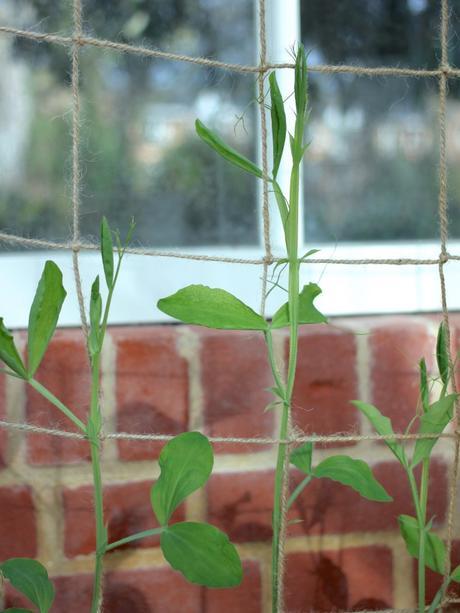
Last year was the first time I had grown winter variety sweet peas in my greenhouse and I found this method of growing under cover was extremely successful. I imagine that it would work well in hotter climates where sweet peas do not succeed when grown outside - in the garden they do best in cooler climates and require a lot of regular water, so anywhere hot and dry is going to struggle to grow them. If these winter variety seeds are sown in early autumn and then grown on under cover in the winter I would expect a very early crop could be achieved in a greenhouse or polytunnel, I cannot test this out myself, but would be very pleased if anyone growing in hot dry conditions would like to give this a go and report back next spring.
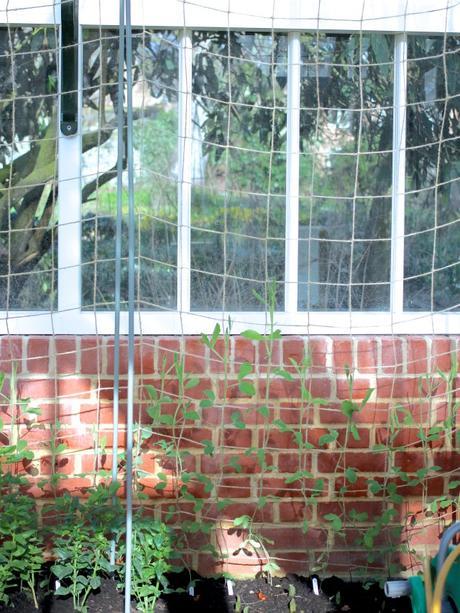
I will be watching my under cover sweet peas very carefully over the next few weeks and will let you know when the first flowers appear.
My summer sweet peas, which will be planted out into the garden, were sown in January and have all germinated now. I just have one more packet of seed to sow which is a mixture of dark shades called the Venetian Sweet Pea Mix from Sarah Raven that I ordered late. The packet has just arrived so I will be soaking the seeds overnight and sowing them tomorrow. The trays of seedlings will be moved into my cold frame in the next week or two and I hope to plant them out in late March. These seedlings will survive well in the deep root trainers they were sown in for quite a few weeks, but I will start to feed them weekly at the end of February to make sure they keep growing healthily until I can plant them out.
Just to recap from my last post - I have weeded the bed where they will be planted and I will be digging in some well rotted manure before the end of February so that it can settle into the soil before I transplant the seedlings into the ground.
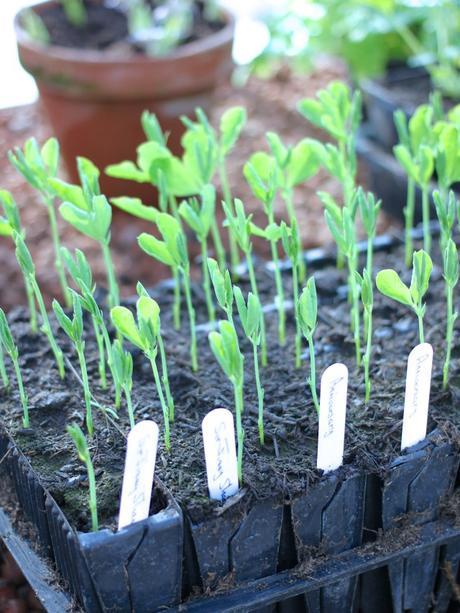
The taller seedlings were sown 2 weeks before the tray below.
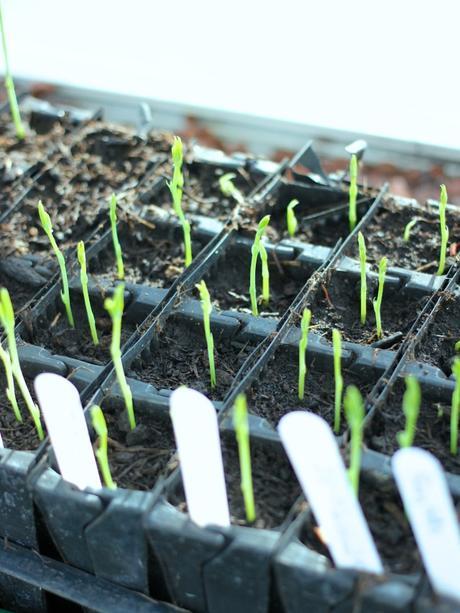
The varieties that I am growing this year are a mix of old favourites and a few new ones. From Owl's Acre Seeds I have sown a selection of my favourite Spencer varieties:
- Gwendoline
- White Frills
- Anniversary
- Sir Jimmy Shard
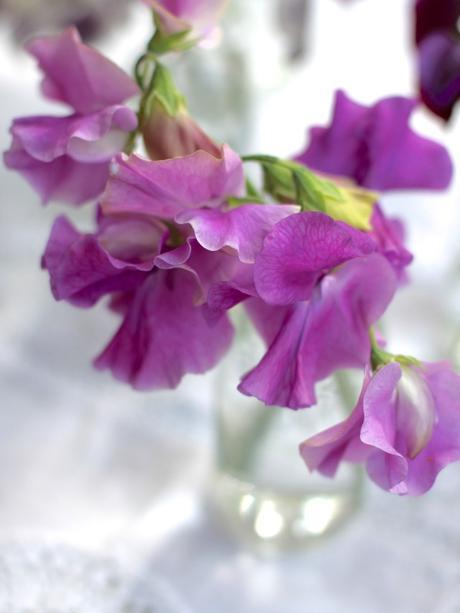
The new varieties are from Mr Fothergill's and are:
- Oxford Blue (modern hybrid)
- Rosy Frills (Spencer variety)
- Charles Angel (Spencer variety)
- Flagship (Spencer variety)

As I mentioned above I also have a mixed packet of dark shades to sow to make sure I have some contrasting colours.
Thank you all for your interest in my last sweet pea post - I was delighted toI receive some very useful comments and questions and I thought it would be helpful to share some of these with you today.
1. Keeping Pollen Beetles Off Sweet Pea FlowersI have really struggled with my garden sweet peas for the past two years as they have been covered in tiny pollen beetles which make them unusable as cut flowers. Teresa suggested not only cutting the flowers and leaving them in a cool dark shed or garbage overnight but also to put a brown paper bag over the flowers to really cut out the light - the idea is that the beetles will leave the flowers in search of daylight. I will certainly be trying this method of clearing the flowers of bugs in the summer, so thank you for this tip Teresa.
2. Protecting Seedlings From MiceMany readers struggle with mice in their greenhouses. Mice love sweet peas seeds and often destroy a newly planted crop. I have been very lucky so far (I am touching wood as I say this) as the mice have stayed out of my greenhouse. Anna from Green Tapestry suggested covering new sowings with a clear propagator lid to protect the seeds - once the plants get going the mice seem to leave them alone. Although I do not have mice in my greenhouse the Cutting Garden is home to plenty of mice, so I know that I could never get away with direct sowing my sweet pea seeds in the garden.
3. Why Have My Plants Got Powdery MildewJulia who grows in Canada was discouraged to find her sweet peas drying out from the bottom up the stems and the leaves developing powdery mildew. My first suggestion is to make sure the plants are well watered and that the ground around them is mulched to preserve the moisture - sweet peas hate to have dry roots. The hotter and more humid the climate the greater the problems with powdery mildew will be. You can treat it with a chemical control if you want to go that route or for organic gardeners I have read that spraying plants with 2/3 tablespoons of baking soda dissolved in a gallon of water once a week will help - this is just a suggestion as I have never tried it. It is hard to stop the stems from drying out lower down as sweet peas tend to flower from higher and higher up the stems as the season progresses, although cutting out dry sideshoots will help with the look of the plants. I grow sweet peas for a short crop of 6-8 weeks (I have usually had enough of dead heading by then) and will take them out as soon as they start to look tatty or overgrown. As a result I have usually pulled them out before any problems develop. I find the sweet pea frame is a great support for a late crop of runner or french beans, so will often compost the plants in mid August to free up the space.
4. Feeding Sweet Pea SeedlingsCathy from Rambling In The Garden asked whether I feed my garden sweet pea seedlings when I am feeding my winter sweet pea plants growing in the greenhouse. I did mention this above, but thought it worth repeating as feeding is so important. From the end of February, every week when I feed my plants growing in the greenhouse bed I will also feed the root trainers to make sure that these seedlings do not go short of food. I use a seaweed feed that I mix in with a watering can of water.
Please do leave any questions that you have in the comments below and also do please share your sweet pea growing experiences here throughout this year - I would love to hear how your sweet peas are getting on.
I am keeping my fingers crossed that lots of you will enter the generous Jute Netting GiveAway - just say that you would like to be entered in the draw in the comments below for a chance to win one of 5 sets of Agriframe's Jute Netting!! Please remember is only open to UK readers.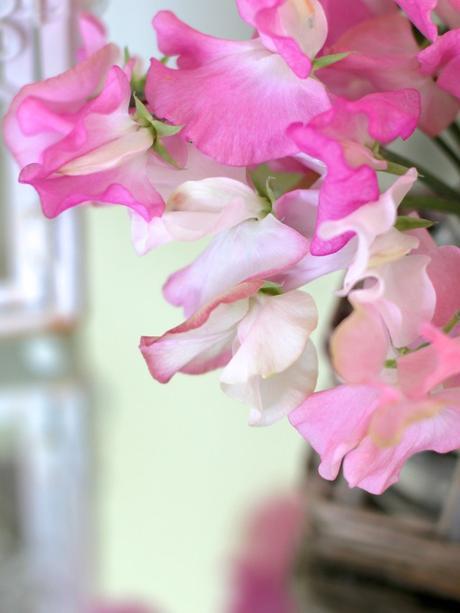
Finally, I must say a very big thank you to Agriframes for sponsoring this post - I will be back with Part 3 in March when I plant my young seedlings outside.

